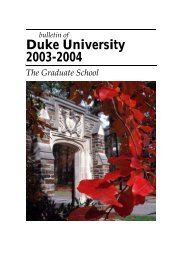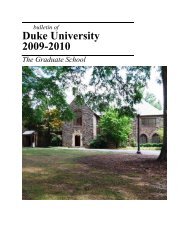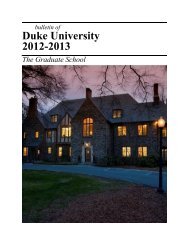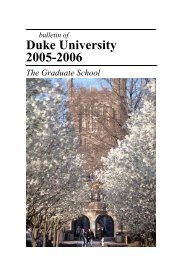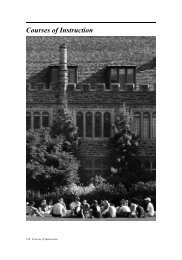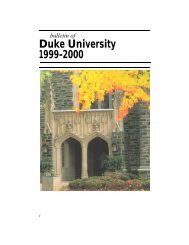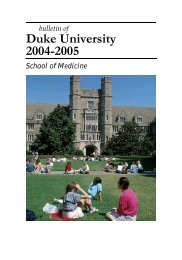Duke University 2008-2009 - Office of the Registrar - Duke University
Duke University 2008-2009 - Office of the Registrar - Duke University
Duke University 2008-2009 - Office of the Registrar - Duke University
You also want an ePaper? Increase the reach of your titles
YUMPU automatically turns print PDFs into web optimized ePapers that Google loves.
241. Linear System Theory and Optimal Control. Consideration <strong>of</strong> system <strong>the</strong>ory<br />
fundamentals; observability, controllability, and realizability; stability analysis; linear<br />
feedback, linear quadratic regulators, Riccati equation, and trajectory tracking. Prerequisite:<br />
Electrical and Computer Engineering 141. Instructor: P. Wang. 3 units.<br />
243. Pattern Classification and Recognition Technology. Theory and practice <strong>of</strong><br />
recognition technology: pattern classification, pattern recognition, automatic computer<br />
decision-making algorithms. Applications covered include medical diseases, severe<br />
wea<strong>the</strong>r, industrial parts, biometrics, bioinformation, animal behavior patterns, image<br />
processing, and human visual systems. Perception as an integral component <strong>of</strong> intelligent<br />
systems. This course prepares students for advanced study <strong>of</strong> data fusion, data mining,<br />
knowledge base construction, problem-solving methodologies <strong>of</strong> "intelligent agents" and<br />
<strong>the</strong> design <strong>of</strong> intelligent control systems. Prerequisites: Ma<strong>the</strong>matics 107, Statistics 113 or<br />
Ma<strong>the</strong>matics 135, Computer Science 6, or consent <strong>of</strong> instructor. Instructor: Collins or P.<br />
Wang. 3 units.<br />
245. Digital Control Systems. Review <strong>of</strong> traditional techniques used for <strong>the</strong> design <strong>of</strong><br />
discrete-time control systems; introduction <strong>of</strong> ''nonclassical'' control problems <strong>of</strong> intelligent<br />
machines such as robots. Limitations <strong>of</strong> <strong>the</strong> assumptions required by traditional design and<br />
analysis tools used in automatic control. Consent <strong>of</strong> instructor required. Instructor: Staff. 3<br />
units.<br />
246. Optimal Control. Review <strong>of</strong> basic linear control <strong>the</strong>ory and linear/nonlinear<br />
programming. Dynamic programming and <strong>the</strong> Hamilton-Jacobi-Bellman Equation.<br />
Calculus <strong>of</strong> variations. Hamiltonian and costatic equations. Pontryagin's Minimum<br />
Principle. Solution to common constrained optimization problems. This course is designed<br />
to satisfy <strong>the</strong> need <strong>of</strong> several engineering disciplines. Prerequisite: Electrical and Computer<br />
Engineering 141 or equivalent. Instructor: Staff. 3 units. C-L: Mechanical Engineering and<br />
Materials Science 232<br />
251. Advanced Digital System Design. This course covers <strong>the</strong> fundamentals <strong>of</strong> advanced<br />
digital system design, and <strong>the</strong> use <strong>of</strong> a hardware description language, VHDL, for <strong>the</strong>ir<br />
syn<strong>the</strong>sis and simulation. Examples <strong>of</strong> systems considered include <strong>the</strong> arithmetic/logic unit,<br />
memory, and microcontrollers. The course includes an appropriate capstone design project<br />
that incorporates engineering standards and realistic constraints in <strong>the</strong> outcome <strong>of</strong> <strong>the</strong> design<br />
process. Additionally, <strong>the</strong> designer must consider most <strong>of</strong> <strong>the</strong> following: Cost, environmental<br />
impact, manufacturability, health and safety, ethics, social and political impact. Each<br />
design project is executed by a team <strong>of</strong> 4 or 5 students who are responsible for generating<br />
a final written project report and making an appropriate presentation <strong>of</strong> <strong>the</strong>ir results to <strong>the</strong><br />
class. Prerequisite: Electrical and Computer Engineering 52L and Senior/graduate student<br />
standing. Instructor: Derby. 3 units.<br />
252. Advanced Computer Architecture I. 3 units. C-L: see Computer Science 220<br />
253. Parallel System Performance. Intrinsic limitations to computer performance.<br />
Amdahl's Law and its extensions. Components <strong>of</strong> computer architecture and operating<br />
systems, and <strong>the</strong>ir impact on <strong>the</strong> performance available to applications. Intrinsic properties<br />
<strong>of</strong> application programs and <strong>the</strong>ir relation to performance. Task graph models <strong>of</strong> parallel<br />
programs. Estimation <strong>of</strong> best possible execution times. Task assignment and related<br />
heuristics. Load balancing. Specific examples from computationally intensive, I/O<br />
intensive, and mixed parallel and distributed computations. Global distributed system<br />
performance. Prerequisites: Computer Science 110; Electrical and Computer Engineering<br />
152. Instructor: Staff. 3 units.<br />
254. Fault-Tolerant and Testable Computer Systems. Technological reasons for faults,<br />
fault models, information redundancy, spatial redundancy, backward and forward error<br />
recovery, fault-tolerant hardware and s<strong>of</strong>tware, modeling and analysis, testing, and design<br />
for test. Prerequisite: Electrical and Computer Engineering 152 or equivalent. Instructor:<br />
Sorin. 3 units. C-L: Computer Science 225<br />
Courses <strong>of</strong> Instruction 149



